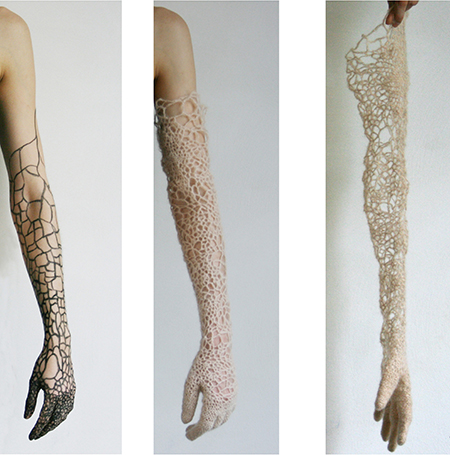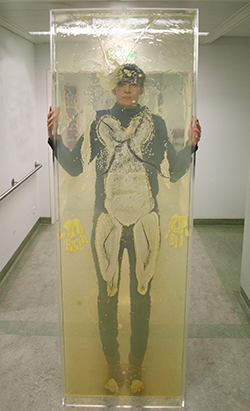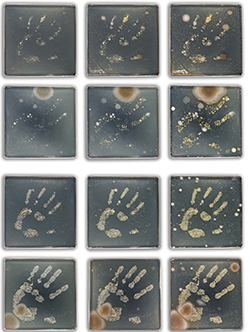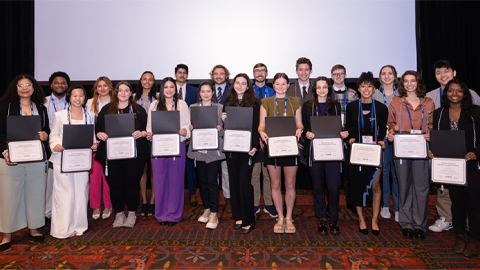Clothed in bacteria
Bioartist Sonja Bäumel is developing new concepts of clothing inspired by the bacteria that coat human skin. Based in Amsterdam and working across the disciplines of art, design, fashion and biology, Bäumel hopes to create awareness of microbial life and make the fashion world take note of the connectedness and continuity of life forms. She has captured and bred her own bacteria to create a visible bacterial map of the body, and she has knit membranelike coverings that are modeled on the actions of colonies of bacteria, which adaptively respond to climactic factors and the body’s thermal requirements.
 In her work “Crocheted Membrane,” Bäumel’s wearable pieces reflect the body’s true thermal requirements.ALL IMAGES COURTESY OF SONJA BÄUMEL
In her work “Crocheted Membrane,” Bäumel’s wearable pieces reflect the body’s true thermal requirements.ALL IMAGES COURTESY OF SONJA BÄUMEL
In her work “Crocheted Membrane,” Bäumel created wearable pieces that cover lightly or more heavily based on the needs of a particular body part to be cooled or warmed. She is looking into slime fungi as a kind of coating of clothing — a visible, flexible membrane that could interact with existing skin bacteria and adapt to its climactic surroundings.The fungi could coat every body differently and become an expression of each individual’s microbiome. And in her project, “(In) Visible Membrane,” Bäumel asked what would happen if clothing could be designed to use skin bacteria’s knowledge of heat and modulate itself actively to cover us in cold and shed when we’re warm.
Born in Vienna, Austria, Bäumel studied fashion design at the Fashion Institute of Vienna and began exploring the idea of clothing as a literal second skin while working on her master’s project in conceptual design in context at the Design Academy Eindhoven in the Netherlands. She ended up interning in a microbiology lab at the Wageningen University in the Netherlands, where she learned to grow and study her own body’s bacteria in various environments.
Our conversation with Bäumel has been edited for length and clarity.
 Bäumel, holding a bacterial map of her body, wants fashion to take note of the connectedness and continuity of life forms.
Bäumel, holding a bacterial map of her body, wants fashion to take note of the connectedness and continuity of life forms.
How did you get started?
During my master’s thesis, I began questioning the fashion system we know today. I wanted to use fashion in a more authentic and meaningful way. I wanted to explore clothing as a second skin and started to look at my work in terms of physiological needs.
What sparked your interest in science and fashion?
I am trying to understand the existing microorganisms living in and on us. During my studies, I was critically reflecting on fashion. I was driven by how clothing or a second skin could look when developed out of one’s socio-physical needs and individual beliefs.
What kind of science is involved in your work?
I have been collaborating for the past seven years with microbiologists and molecular biologists, depending on the project’s needs.
Can you talk about the different work you did in microbiology labs?
I worked in different labs, and in 2008, at the Wageningen University, I grew my skin’s bacteria using agar from 30 different parts of my body.
This was aesthetically pleasing to the eye. It was amazing to see my body’s bacteria growing independently of my body in a Petri dish.
In another project, “Cartography of the Human Body,” I walked outside on one day in Vienna to cultivate bacteria from my own skin. I (came back inside) then collected the bacteria of my temporary skin flora and grew them first on agar plates. The different morphologies, colors and quantities of bacteria on different body areas were examined, analyzed, counted and documented. The bacteria were bred, partially reanimated and stored at -70 degrees C. In the framework of an interaction study, experiments were made to study the bacteria’s hierarchies. Weak bacteria that didn’t seem to grow much at all or grew smaller were applied first to guarantee their unhindered growth and to achieve the desired colors on the bacteria’s image. The colors emerged naturally from the different bacteria species found on this specific day on the human skin.
Bacteria in fluid culture are invisible. When you let them grow on an agar plate they (become) visible. After applying an invisible bacterial fluid on the body, a body print was made on a textile material that had been provided with nutrients to support the bacteria’s growth. As soon as the bacteria visibly grew, their growth was stopped, and the actual state was documented with a body print.
My first synthetic biology-related project was a collaborative work called “Metabodies,” which I worked on during a residency at the Ars Electronica Futurelab/Biolab in Linz, Austria. Synthetic biology allowed us to obtain and visualize data deriving from the human body. (We focused on) the human skin bacterial species staphylococcus aureus and staphylococcus epidermis. These bacteria are known for performing quorum sensing through a peptide and are visualized by using the bacteria escherichia coli modified with green fluorescent protein.
(With this project) we were also aiming to bring synthetic biology into social spheres, to raise questions and provoke a dialogue with the general public regarding current scientific discoveries.
How did your scientific research influence the crocheted membrane?
 Bäumel has grown skin bacteria from 30 different parts of her body.
Bäumel has grown skin bacteria from 30 different parts of her body.
The crocheted membrane emerged out of interviews I conducted with scientists and also out of a microbiology lab internship. The crocheted membrane is not living (and is part of a larger project called the ((In)visible membrane)). To explain my (In)visible membrane work further, I made the (in)visible film.
This film shows the four layers of the (in)visible membrane: already existing skin bacteria, a communication layer, a slime mold and plants, and how theoretically this clothing could transmute into different forms, colors and functions related to environmental changes. Finally, the film shows plants growing from a human skin, and it portrays a human being who is able to breathe underwater — a utopian vision and inspiration.
What did you learn from intersecting fashion and art with science?
One thing I immediately recognized as a creative entering the scientific realm was that scientists focus on their own microcosm. There’s a scientist working with skin bacteria, one working with plant bacteria, etc., and they don’t really communicate with each other. I think a huge advantage on the creative side is that you somehow recognize relationships more easily and connect them. Scientists are very fruitful collaborators, and these collaborations will work as long as both partners accept each other. Often, I go in and ruffle their world with extremely simple questions that kick them out of their comfort zones. As an independent artist, I can maneuver more easily through what’s going on in that environment.
What does the future hold for you?
I recently received funding to start a new project, which kicked off in October. It’s going to be an even more interdisciplinary project, as I’ll be working with a scientist, a cultural historian and a fellow artist. This artistic research project focuses on current biological discoveries, such as the human microbiome, the related shift from genomics to metagenomics and the evolving perception of what our body is composed of. For the first time in my work, I will be using metagenomics methodologies that will allow me to better analyze and show microbial social interactions.
Enjoy reading ASBMB Today?
Become a member to receive the print edition monthly and the digital edition weekly.
Learn moreGet the latest from ASBMB Today
Enter your email address, and we’ll send you a weekly email with recent articles, interviews and more.
Latest in People
People highlights or most popular articles

ASBMB inducts new honor society members
Chi Omega Lambda, which recognizes exceptional juniors and seniors pursuing degrees in the molecular life sciences, has 31 inductees in 2024.

2024 voter guide
Learn about the candidates running for ASBMB Council, Nominating Committee, Publications Committee and treasurer.

Charles O. Rock (1949 – 2023)
Colleagues and trainees remember a world expert in membrane lipid homeostasis.

Honors for Clemons, Hatzios and Wiemer
Awards, honors, milestones and more. Find out what's happening in the lives of ASBMB members.

Touching the future from the bench
Scholar, scientist, teacher and mentor Odutayo Odunuga discusses the important roles of the institutional PI, his journey and his research.

In memoriam: Darwin Prockop
He held leadership positions at multiple institutions and was known for his contributions to adult stem cell biology and cellular biology.

